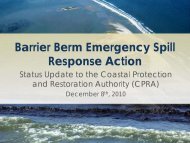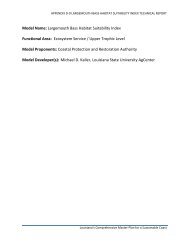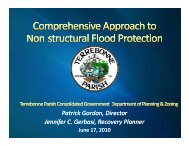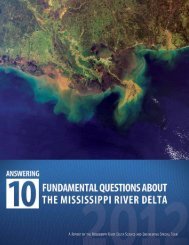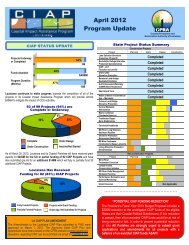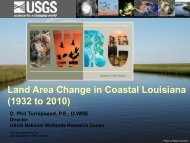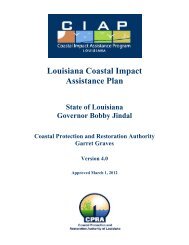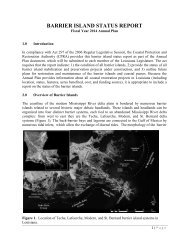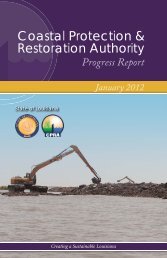Appendix G5a â Public Comments - Coastal Protection and ...
Appendix G5a â Public Comments - Coastal Protection and ...
Appendix G5a â Public Comments - Coastal Protection and ...
Create successful ePaper yourself
Turn your PDF publications into a flip-book with our unique Google optimized e-Paper software.
geological aspects of the plan or its technical integration of those variables, rather I address hereprimarily the socio-economic <strong>and</strong> socio-cultural aspects of the plan <strong>and</strong> the ultimately politicalassumptions <strong>and</strong> decisions the CPRA has chosen in its construction of the plan.I agree with the plan’s acknowledgment of the lack of social science incorporated into it, <strong>and</strong> callon the CPRA to exp<strong>and</strong> its engagement with Cultural Heritage <strong>and</strong> Socio-Economics throughTechnical Advisory Commitees on these topics with more <strong>and</strong> new members as well as aCultural Heritage Communities Focus Group. At present, both the academic <strong>and</strong> lay personsinvolved officially in the Master Plan process are highly imbalanced towards ecological science<strong>and</strong> engineering <strong>and</strong> the representatives of politically powerful industries in the state at theexpense of social science, the humanities, <strong>and</strong> residents of coastal communities, especially thosewho represent racial, ethnic, <strong>and</strong> linguistic minority groups that embody much of the region’sliving cultural heritage.The planners have repeatedly made use of what has become known as the “Red Map” – the chartshowing 1,756 sq. miles of l<strong>and</strong> loss over the next 50 years under the so-called ‘less optimistic’scenario. My observation on the use of this map in public meetings is that the CPRA is using itssea of red to quiet criticism of the plan – saying, while pointing to the map, that ‘we are allvulnerable’ <strong>and</strong> we must attain concensus, presumably for the 2012 plan, to prevent this dreadscenario. Yet, I must say that the CPRA is selectively over-stating the l<strong>and</strong> loss scenario when itis useful for berating skeptical coastal Louisiana audiences, while it chooses to under-estimatethe scientific evidence that shows we may be heading for an even more discouraging futurewhile simultaneously drawing upon a greatly underestimated l<strong>and</strong> change future, the ‘moderate’environmental scenario, in making its argument to federal funders that the State of Louisiana canachieve no net loss of wetl<strong>and</strong>s <strong>and</strong> greatly reduce storm vulnerability at what has become the‘cheap’ price of $50 billion. I appreciate the political logic of this strategic choice of scenarios toconvince different stakeholders to get on board, while I note its disingenuousness.While it is true the plan documents different l<strong>and</strong> loss <strong>and</strong> storm damage numbers for both themoderate <strong>and</strong> less optimistic scenarios (pages 16-17, 24-25), several important underlyingassumptions either unaddressed or only marginally acknowledged in the plan’s voluminousappendices make these scenarios questionable. As you explain on page 76 of the plan, under themoderate environmental scenario only 771 sq. mi. will be lost in the ‘Future Without Action’variant; a considerably less scary map results from this variant which does not impress upondown the bayou residents the same degree of ‘we’re all in this together’ the crimson tide of l<strong>and</strong>loss in the 1,756 sq. mi. map does.Much more concerning, however, is the low-balling of future l<strong>and</strong> change processes in the plan’senvironmental scenarios; the plan’s moderate scenario only expects 0.27 meters of sea level rise /50 years, while even the plan must admit (in rather fine print back in <strong>Appendix</strong> C, page 7) that itshigher bound, 0.45m / 50 yrs., is about 50% less than the NRC’s high estimate of 0.65m <strong>and</strong>about half of the contemporary peer-reviewed estimate of 0.78m / 50 yrs. This number, as youwell know, means the difference whether any feasible amount of spending is going to achieve netno wetl<strong>and</strong> loss by 2062; if actual future sea level rise approaches these high estimates, thenwe’re screwed in South Terrebonne whatever amount of money is thrown at the problem, <strong>and</strong>that reality is not reflected in the plan; instead, a scary but not insurmountable future scenario is



